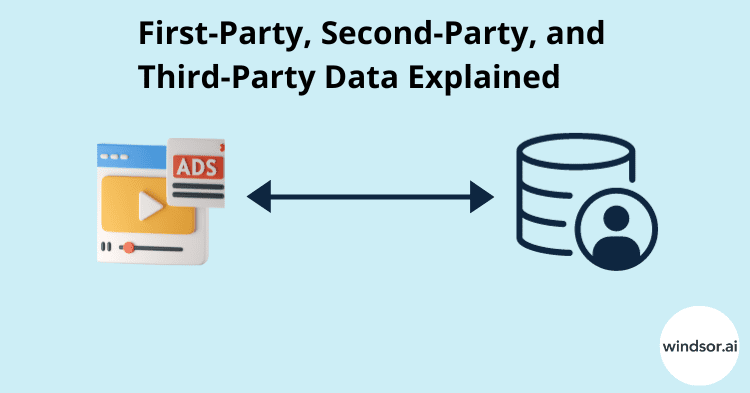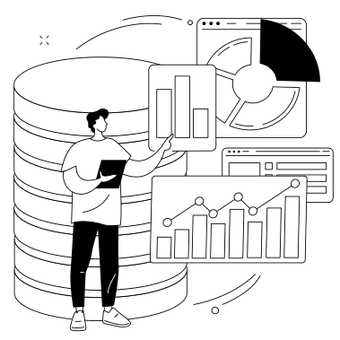First-Party vs Second-Party vs Third-Party Data

What do terms such as third-party, second-party, and first-party data signify?
This article will delve into the distinctions among these data categories and explore ways to leverage each for enhancing your marketing strategy and campaigns.
In this post:
- What is the difference between 1st party, 2nd party, and 3rd party data?
- First-Party Data
- Second-Party Data
- Third-Party Data
- In Conclusion: First party data vs Second party data vs Third party data
- FAQ
What is the difference between 1st party, 2nd party, and 3rd party data?
What sets apart first-party, second-party, and third-party data? At their core, all these data types offer valuable insights that companies use to comprehend themselves, their customers, industry dynamics, and competitive landscapes. Data plays a pivotal role in guiding strategies across various business facets, including development, marketing, sales, supply chain management, and inventory control in supply chain management.
Here’s a breakdown of each data type:
- First-party data originates from a brand’s audience, encompassing customers, visitors, and followers. This information is willingly shared by the audience to engage with the brand and its offerings. Examples of first-party data include user feedback, survey results, purchase history, website and app activities, social media profiles, interactions, and customer relationship management systems. Innovative tools like the QR code Generator, loyalty apps, and interactive kiosks can also play a pivotal role in gathering first-party data. By utilizing methods such as QR codes on product packaging, app-based surveys, or in-store touchpoints, brands can seamlessly collect data while enhancing customer engagement.
- Second-party data, on the other hand, comes from a brand’s trusted partners or other organizations. These partners share information for mutual benefit, and the data essentially mirrors that of first-party data, differing only in its origin and the subjects it pertains to.
- Third-party data is sourced from external entities and companies unrelated to a brand or its audience. External sources provide this information to offer industry and market insights that enable brands to formulate informed strategies. Examples of third-party data include user feedback, website and app interactions, as well as interview and focus group responses.
Recently, certain elements of first-party data have been categorized as zero-party data. Zero-party data is intentionally and proactively provided by customers to businesses, allowing brands to better understand and meet their needs. Examples of zero-party data include previously classified first-party data such as preference centers, survey responses, and poll results.
First-Party, Second-Party, and Third-Party Data Explained
The distinction between first-party, second-party, and third-party data is crucial for marketers in understanding the source, trustworthiness, and usage of the data they leverage for their campaigns.
First-Party Data
- Definition: Data that a company collects directly from its own platforms, such as its website, app, or CRM system.
- Examples: Website traffic, survey responses, customer data (purchase history, time spent on the website, number of visits, emails, phone numbers).
- Importance: Highly valuable because it comes directly from the company’s own audience, providing insights into customer preferences and behavior.
- Usage: Enables better targeting, personalized ads, and improved marketing strategies.
- Consent: The user’s consent is essential, especially in light of privacy laws like GDPR, and can be managed through consent management platforms in order to comply with data privacy regulations.
Why is obtaining consent crucial when utilizing consumer data?
The user’s consent plays a pivotal role in how marketers employ their first-party data, and this has become even more crucial with the implementation of GDPR, as consumers now possess rights under European Union law. These rights empower individuals to control the information collected by companies about them, necessitating verifiable informed consent before processing any personal details, including online activities such as browsing habits or purchase history.
First-party data holds greater value than other forms of business data as long as it is generated from sources owned by the entity.
An additional way to harness the potential of first-party data is by sending customized emails to customers, featuring specific products they have viewed on an app or webshop.
In summary, first-party data is indispensable for the marketing efforts of a modern company. Marketers can leverage first-party data for various purposes, such as crafting ideal customer profiles to enhance future campaign planning or utilizing website behavior to optimize landing pages for visitors. It becomes even more effective when combined with a GTM server container.
Second-Party Data
- Definition: First-party data shared or sold by one company to another, typically through a trusted partnership.
- Example Scenario: A hotel booking website and an air travel website sharing data to target customers more effectively.
- Importance: Provides access to a partner’s first-party data, expanding the pool of insights and targeting possibilities.
- Trust: Relies on a trusted relationship between the two companies involved.
Third-Party Data
- Definition: Data collected by a company that does not have a direct relationship with either the selling or buying party.
- Examples: Aggregated data lists like “People who enjoy football” or “People who like dogs” on social media.
- Importance: Can be powerful for broad targeting, but quality varies, and careful consideration is needed regarding the source.
- Concerns: Privacy laws and increasing restrictions on third-party cookies may impact the reliability and usage of third-party data. Company data providers play a major role in the third-party ecosystem, collecting and distributing insights that help businesses with audience targeting, trend analysis, and strategic planning.
In Conclusion: First party data vs Second party data vs Third party data
In summary, the key lies in understanding the origin, trustworthiness, and utility of different types of data.
Marketers are encouraged to prioritize first-party data, build strategic partnerships for second-party data, and exercise caution with third-party data, especially considering evolving privacy laws and the changing landscape of digital advertising.
Windsor.ai provides a solution that allows you to seamlessly integrate and consolidate your marketing, customer relationship management, and analytics data from over 75 platforms.
This unified data can then be efficiently streamed to various destinations, including spreadsheet tools, business intelligence (BI) platforms, or your data warehouse.
- The setup is done in minutes
- No coding is required
- All connectors available on all plans
- Comprehensive collection of templates for marketing dashboards
- SOC 2 Type 2 certified, supports single sign on and multi factor authentication
- Database destination pricing independent of row count

Try Windsor.ai today
Access all your data from your favorite sources in one place.
Get started for free with a 30 - day trial.
FAQ
Are cookies considered a valuable resource for marketers?
Cookies enable marketers to gather valuable insights such as visitor information, track behavior, and identify their ideal customers.
This wealth of information allows for improved targeting, more effective ads, and enhanced overall marketing strategies through the analysis of diverse audience segments.
What Is Zero-party Data?
In the ongoing discussion about 1st-party, 2nd-party, and 3rd-party data, a relatively new category has emerged—zero-party data. Despite its confusing nature, it shares many similarities with first-party data.
Examples of zero-party data encompass explicit information provided by consumers, such as communication preferences or the types of information they wish to receive. Interests also fall under this category, where consumers explicitly communicate their preferences.
It’s crucial to note that zero-party data is a subset of first-party data and must adhere to the same management regulations, offering similar benefits in terms of creating personalized and relevant experiences.
Is the Reliability of Third-Party Data Consistent?
The reliability of third-party data can differ as it is collected by companies without a direct relationship with the individuals the data pertains to. Caution is advised in utilizing third-party data due to privacy laws.
How is Second-Party Data Different from First-Party Data?
Second-party data involves the sharing of another company’s first-party data through a partnership, providing reliability and potential insights not accessible via first-party data.


